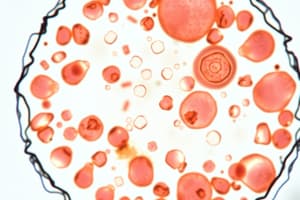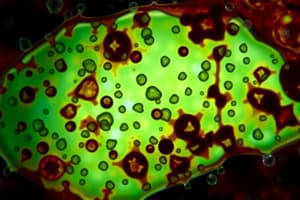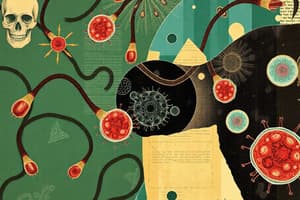Podcast
Questions and Answers
Which of the following statements accurately reflects a key tenet of the cell theory?
Which of the following statements accurately reflects a key tenet of the cell theory?
- Cells can spontaneously generate from non-living matter under specific conditions.
- All living organisms consist of multiple tissues but do not require a cellular structure.
- New cells arise exclusively from pre-existing cells through the process of cell division. (correct)
- All cells are capable of performing photosynthesis given the right environmental factors.
A scientist is comparing two cells: one large and one small. Considering the surface area-to-volume ratio, which cell is more efficient at exchanging nutrients and waste with its environment, and why?
A scientist is comparing two cells: one large and one small. Considering the surface area-to-volume ratio, which cell is more efficient at exchanging nutrients and waste with its environment, and why?
- The smaller cell, because it has a higher surface area-to-volume ratio. (correct)
- The smaller cell, because its smaller volume requires less exchange.
- The larger cell, because it has a greater surface area for absorption.
- Both cells are equally efficient, as the surface area-to-volume ratio is constant.
If a cell were unable to produce ATP, which organelle is most likely malfunctioning?
If a cell were unable to produce ATP, which organelle is most likely malfunctioning?
- Mitochondrion (correct)
- Ribosome
- Nucleus
- Vesicle
Bile, produced by the liver, is essential for the digestion and absorption of fats. If a person's liver is damaged and not producing enough bile, which of the following processes would be most affected?
Bile, produced by the liver, is essential for the digestion and absorption of fats. If a person's liver is damaged and not producing enough bile, which of the following processes would be most affected?
Which of the following best describes the primary function of alveoli in the respiratory system?
Which of the following best describes the primary function of alveoli in the respiratory system?
In the circulatory system, which type of blood vessel is responsible for carrying deoxygenated blood back to the heart?
In the circulatory system, which type of blood vessel is responsible for carrying deoxygenated blood back to the heart?
After running a race, a runner's breathing rate increases. Which muscle plays the most direct role in increasing the volume of the chest cavity during inhalation to meet the increased oxygen demand?
After running a race, a runner's breathing rate increases. Which muscle plays the most direct role in increasing the volume of the chest cavity during inhalation to meet the increased oxygen demand?
A scientist is examining a cell under a microscope and observes the presence of a cell wall, chloroplasts, and a large central vacuole. Based on these observations, from which type of organism did this cell most likely originate?
A scientist is examining a cell under a microscope and observes the presence of a cell wall, chloroplasts, and a large central vacuole. Based on these observations, from which type of organism did this cell most likely originate?
When comparing observations made using a compound light microscope versus an electron microscope, which of the following characteristics is true for the electron microscope?
When comparing observations made using a compound light microscope versus an electron microscope, which of the following characteristics is true for the electron microscope?
A researcher collects the following data points for the height of a plant over several weeks: 2cm, 4cm, 6cm, 8cm, and 10cm. What is the mean height of the plant based on this data?
A researcher collects the following data points for the height of a plant over several weeks: 2cm, 4cm, 6cm, 8cm, and 10cm. What is the mean height of the plant based on this data?
Flashcards
Cell Theory
Cell Theory
All living things consist of cells. Cells are the basic unit of life. All cells come from pre-existing cells.
Surface Area-to-Volume Ratio
Surface Area-to-Volume Ratio
The measurement relating a cell's outer surface to its internal volume; impacts material exchange efficiency. Smaller cells have a greater ratio.
Cell Membrane
Cell Membrane
Controls what enters and exits the cell, providing a barrier and maintaining cell integrity.
Nucleus
Nucleus
Signup and view all the flashcards
Mitochondria
Mitochondria
Signup and view all the flashcards
Ribosomes
Ribosomes
Signup and view all the flashcards
Chloroplasts
Chloroplasts
Signup and view all the flashcards
Vesicles
Vesicles
Signup and view all the flashcards
Types of Digestion
Types of Digestion
Signup and view all the flashcards
Alveoli
Alveoli
Signup and view all the flashcards
Study Notes
- All living things are made of cells
- Cells are the basic unit of life
- Cells come from pre-existing cells
Surface Area-to-Volume Ratio
- Smaller cells can exchange materials faster than larger cells
Organelles and Functions
- Cell Membrane: controls the entry and exit of substances into and out of the cell
- Nucleus: stores DNA and controls the cell's activities
- Mitochondria: produces energy in the form of ATP
- Ribosomes: responsible for making proteins
- Chloroplasts: found only in plants, conduct photosynthesis
- Vesicles: transport materials within the cell
Plant vs. Animal Cells
- Plant Cells: Have cell walls, chloroplasts, and large vacuoles
- Animal Cells: Have centrioles, lysosomes, and lack a cell wall
Microscopes
- Electron Microscope: provides high detail imaging
- Compound Light Microscope: allows for basic viewing of cells
- Stereo Light Microscope: provides a 3D view at low magnification
Levels of Organization
- Cells: the basic unit of life, for example a muscle cell
- Tissues: groups of cells performing a similar function, e.g., muscle tissue
- Organs: structures made of tissues, such as the heart
- Body Systems: organs working together, e.g., the circulatory system
Digestive System
- There are two forms of digestion: physical and chemical
- Physical Digestion: involves chewing and stomach churning
- Chemical Digestion: involves enzymes breaking down food, such as amylase breaking down starch
Key Organs
- Mouth: begins digestion by chewing
- Stomach: uses acid and enzymes to further digest food
- Small Intestine: absorbs nutrients from digested food
- Large Intestine: absorbs water and forms waste
- Liver: produces bile for fat digestion
- Pancreas: releases digestive enzymes
Respiratory System
Key Organs
- Trachea: carries air to the lungs
- Bronchi: branches that carry air into the lungs
- Lungs: facilitates gas exchange
- Alveoli: tiny sacs specialized for oxygen exchange
- Diaphragm: controls breathing
Circulatory System
- Heart: pumps blood throughout the body
Blood Vessels
- Arteries: carry oxygen-rich blood away from the heart
- Veins: carry oxygen-poor blood to the heart
- Capillaries: facilitates gas exchange
Blood Components
- Red Blood Cells: carry oxygen using hemoglobin
- White Blood Cells: fight infections
- Platelets: help clot blood
- Plasma: transports nutrients and hormones
Data Analysis and Graphing
- Mean (Average): calculated by summing the values and dividing by the number of values
Graphing Steps
- Label the x-axis (independent variable) and y-axis (dependent variable)
- Plot the data points, and calculate the mean
- Draw a trend line or curve
- Describe the trend as increasing, decreasing, or steady
- Identify relationships as positive or negative correlations
Studying That Suits You
Use AI to generate personalized quizzes and flashcards to suit your learning preferences.




